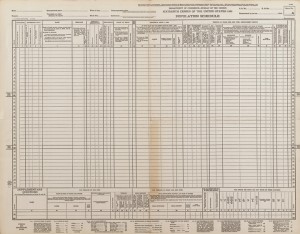Something BIG will happen Monday. Something genealogists all across the country have been eagerly awaiting for 10 years.
At 9:00 a.m. Eastern Time, April 2nd, nearly every genealogist in America will be on the Internet to view the 1940 US Federal Census for the first time.
The digitized 1940 Census will be released by the National Archives and Records Administration (NARA) Monday and will be made available for viewing on the special NARA 1940 Census website free of charge.
Census enumerations can be released to the public 72 years after the enumeration. There hasn’t been this much excitement in the genealogy world since the 1930 census was released on 1 April 2002.
The US Census Bureau has some interesting facts about the 1940 census. This census was taken near the end of the Great Depression but before our entry into World War II. It was the only census taken during the presidency of Franklin D. Roosevelt.
There were a total of 81 questions asked in the 1940 Census: 34 concerning population, 31 pertaining to housing and 16 supplemental population questions asked of 5% of the people.
There were some new questions asked in 1940: where was their residence five years earlier, their income, the highest level of school completed, unemployment history, who was the informant. Some of the questions were added to measure the effects of the Great Depression.
It was also the first census to ask a random sample of the population (about 1 in 20) an extra set of more detailed questions. These questions included birth place of mother and father, mother tongue, veteran status, occupation, industry, class of worker, age at first marriage, number of children born, and others.
Census enumerators were told to visit every house, building, tent, cabin, hut or any other place in which a person might be living. During the visit enumerators interviewed residents and recorded answers in a portfolio-sized book.
Initially, searching for people in the 1940 census will be challenging and will require a little homework beforehand. The images released by the NARA on Monday do not have a name index. In this digital age we are spoiled. We can go to FamilySearch.org or Ancestry.com or Heritage Quest and search for names in any census because all censuses released thus far have been indexed.
Do not despair. The 1940 census will soon be indexed. Soon after its release thousands of volunteers will begin work to index the more than 132 million people enumerated in 1940. But it will take a few months for the indexing to be complete. Information about indexing is on the Community 1940 US Census Project.
In the meantime, how will you find someone in the un-indexed 1940 census? To locate someone you will need to know the enumeration district (ED) in which they were living. The enumeration district is an administrative division of a particular county or township for the purposes of census-taking. You may be able to determine the ED ahead of time if you know the person’s address in 1940. If they didn’t move around you can probably use their 1930 address or their 1930 ED.
Steve Morse has devoted a portion of his website to help determined enumeration districts. I used his Unified 1940 Census ED Finder to determine the EDs of my Miller and Schumm relatives and some nearby areas. To the best of my knowledge the following will be the enumeration districts for these areas. I assume that once I get to the specific ED I will scroll through the pages, the way we used to look through microfilm, before indexing. I will be searching mainly rural areas. Determining the ED in a city is a little different.
Mercer County, Ohio, Roll 3114:
Black Creek Township & part of Chattanooga: ED 54-1 (pop. 886)
Dublin Township, Rockford: ED 54-5 (pop. 1066)
Dublin Township (outside Rockford): ED 54-6 (pop. 1018)
Liberty Township & part of Chattanooga: ED 54-22 (pop. 1194)
Van Wert County, Ohio, Roll 3163:
Willshire Township (outside Willshire & Wren villages): ED 81-28 (pop. 997)
Willshire Village: ED 81-26 (pop. 513)
Adams County, Indiana: Roll 1024:
Jefferson Township: ED 1-4 (pop. 700)
Geneva: ED 1-20 (pop. 966)
Wabash Township (outside Berne & Geneva): ED 1-21 (pop. 1271)
The NARA also has 1940 Census Maps to determine enumeration district numbers. Enter in the search box: 1940 census maps + county + state. (e.g. 1940 Census Maps Mercer Ohio)
Who will I be looking for in the 1940 census on Monday? Most of the ancestors I am seeking were long deceased by 1940 but it will be interesting to view information about people I remember and know. And it will be interesting to see how they answered the census questions.
I hope to locate the household of my parents, grandparents and some of my great-grandparents. All of my grandparents were living in 1940 as well as three of my great-grandparents. Great-grandmothers Christina (Rueck) Miller, Pearl (Reid) Brewster, Lizzie (Schinnerer) Scaer would have been enumerated that year. I believe two of them were living with their children.
For additional information about the 1940 US Census visit NARA 1940 Census Records, 1940 U.S. Federal Census and Family Tree Magazine’s census article.
According to Dick Eastman this census will be the first to use cloud computing in order to handle the expected sudden increase in workload of the servers during the first few days. The servers at 1940census.archives.gov will actually be a collection of hundreds of servers in the cloud.
I hope they are ready for all the Internet traffic at 9:00 this coming Monday morning. Look out! Here we come!



